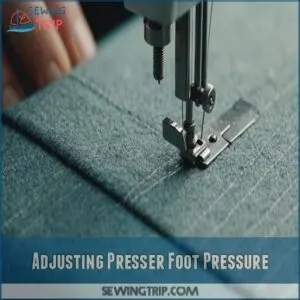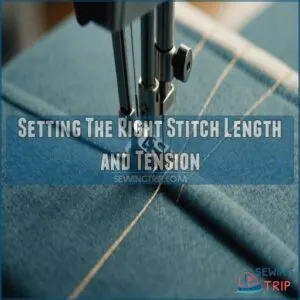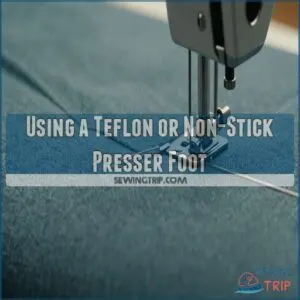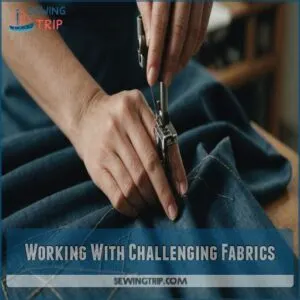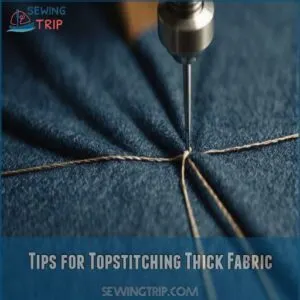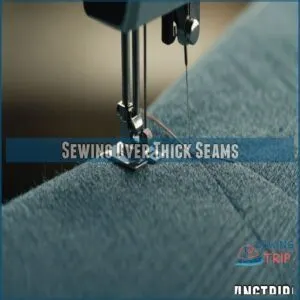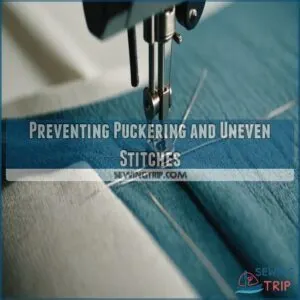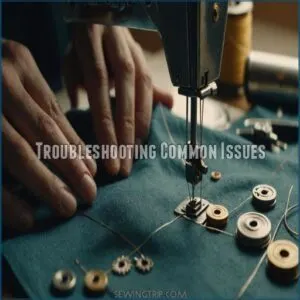This site is supported by our readers. We may earn a commission, at no cost to you, if you purchase through links.
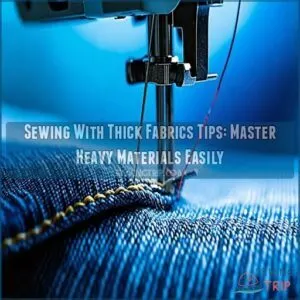 Tackling thick fabrics doesn’t have to be a wrestling match between you and your sewing machine.
Tackling thick fabrics doesn’t have to be a wrestling match between you and your sewing machine.
First, choose a sturdy size 16 or 18 needle along with heavy-duty thread to handle the heft.
Adjust your machine’s tension and presser foot to glide over those layers smoothly, avoiding broken needles or skipped stitches.
A walking foot or Teflon foot can help move the fabric like a dream.
Don’t forget to pre-wash your fabric to prevent puckering later.
Need more tailor-made tricks for those tricky textiles? We’ve got plenty up our sleeve to guarantee you master the art of sewing with thick fabrics.
Table Of Contents
- Key Takeaways
- Choosing The Right Tools
- Essential Techniques for Sewing Thick Fabrics
- Adjusting Your Sewing Machine
- Common Mistakes to Avoid
- Working With Challenging Fabrics
- Tips for Topstitching Thick Fabric
- Sewing Over Thick Seams
- Preventing Puckering and Uneven Stitches
- Troubleshooting Common Issues
- Frequently Asked Questions (FAQs)
- Conclusion
Key Takeaways
- Use heavy-duty needles (sizes 16-18) and strong thread to tackle thick fabrics and ensure smooth sewing without breakage.
- Adjust your sewing machine’s presser foot pressure and stitch length to prevent skipped stitches and manage fabric thickness effectively.
- Pre-wash thick fabrics to avoid shrinkage and puckering later, ensuring your final product maintains its shape.
- Slow down and take your time to avoid common mistakes like neglected needle care or rushing, which can lead to errors and frustration.
Choosing The Right Tools
When sewing with thick fabrics, selecting the right tools is essential for achieving clean and professional results.
You’ll need heavy-duty needles, high-quality thread, and sharp scissors to handle these robust materials with ease.
Heavy-Duty Needles for Heavy-Weight Materials
Because you’re tackling thick fabrics, choosing the right needle is key.
Look for heavy-duty needles; sizes 16-18 are common for denim and canvas.
Needle types like denim or leather needles are designed to pierce tough materials.
Schmetz and Organ are reputable brands known for needle longevity.
Proper needle care, like storing them safely, extends their lifespan and prevents skipped stitches.
Remember, a sharp needle makes all the difference!
High-Quality Thread for Thick Fabrics
After choosing the right heavy-duty needle, it’s time to match it with high-quality thread.
You’ll want strong, thick thread, like those from top thread brands, to handle dense fabrics.
Consider thread weight and thread type for durability.
Don’t forget thread color for a seamless look.
Remember, the best thread strength keeps your stitches holding firm, even under pressure.
Sharp Scissors for Cutting Thick Fabric
High-quality thread is handy, but don’t underestimate sharp scissors when tackling thick fabric.
Picture them as your reliable sidekick, slicing through layers like butter.
When choosing scissors, look for those with high-grade stainless steel blades, which maintain sharpness and resist dulling.
Consider these tips:
- Choose scissors designed for thick fabrics.
- Maintain sharpness to avoid snagging.
- Use steady, controlled cutting techniques.
- Practice safety—keep fingers clear and blades closed when not in use.
Essential Techniques for Sewing Thick Fabrics
Now that you’ve got the right tools, let’s chat about techniques for sewing thick fabrics.
First, remember fabric selection is key; pick something resilient like denim or canvas.
To get the best results, consider investing in a machine specifically designed for heavy-duty use, like a denim sewing machine.
Then, when it comes to seam finishing, try a flat-fell or French seam—these keep edges tidy and strong.
As for top stitching, go slow and steady; this adds both style and function to your work.
With machine maintenance, keep your gear in top shape; a well-oiled machine loves thick cloth.
Finally, project planning is your blueprint for success, offering guidance each step of the way.
Sewing thick fabrics is no small feat, but you’re well on your way to mastery.
Adjusting Your Sewing Machine
To handle thick fabrics efficiently, you’ll need to adjust your sewing machine with precision.
By modifying presser foot pressure, stitch length, and tension—plus using a Teflon presser foot—you’ll prevent common pitfalls and achieve smooth stitching.
Adjusting Presser Foot Pressure
Mastering presser foot pressure is like adjusting the sails on a boat; it makes working with thick fabric smooth.
By easing up pressure, your fabric feeds evenly, preventing jagged stitches.
Listen to your sewing machine’s purr; it’s music telling you you’ve nailed it.
Tweak it right, and even the bulkiest fabric feels like smooth sailing.
Setting The Right Stitch Length and Tension
When you’re sewing thick fabrics, adjusting stitch length and tension is very important, especially with the help of a heavy duty sewing machine.
Think of it as dialing in your machine’s settings to accommodate fabric thickness.
Longer stitches prevent tight puckers, while adjusting tension avoids thread breakage.
Keep in mind, balancing these elements hinges on needle size and stitch quality, ensuring your fabric flows smoothly, even when layers stack up.
Using a Teflon or Non-Stick Presser Foot
Why struggle with thick fabrics?
A Teflon or non-stick presser foot is your secret weapon!
This amazing tool lets your fabric glide smoothly under the needle, preventing frustrating jams and puckering.
Many types are available; choose one that fits your machine.
Proper foot care extends its life, ensuring effortless sewing.
Enjoy the benefits of a consistent stitch!
Common Mistakes to Avoid
When you’re working with thick fabrics, you need to steer clear of common mistakes that can undermine your sewing project.
Avoiding pitfalls like using the wrong stitch type or neglecting needle care can mean the difference between frustration and success.
Using The Wrong Stitch Type
Choosing the wrong stitch type can turn your sewing project into a tangled mess.
It’s important for stitch selection to match the fabric’s stretch and required seam durability.
A zigzag stitch can accommodate fabric movement, while a straight stitch suits stable materials.
Consider seam allowance and tension issues to make sure stitches hold firm without pulling or puckering.
Neglecting Needle Care
Neglecting needle care can lead to troubles like needle breakage and skipped stitches.
1. Regularly check for bent or dull needles.
2. Match needle size and type to your fabric, like denim or leather.
3. Replace needles after eight hours of use to keep them sharp.
4. Keep spare needles handy; nothing stops a project cold like a broken needle.
Rushing Through Projects
It’s tempting to rush sewing projects, but patience is key.
Ever tried racing against time, only to land with a tangled mess?
Time management is essential; project pacing directly affects stitch quality.
Hasty sewing can lead to errors, raising frustration levels.
Slow down, savor the process, and watch how your fabric masterpiece unfolds smoothly without a hitch.
Failing to Adjust Machine Settings
Speeding through projects without checking machine settings can lead to issues like puckering, uneven stitches, and thread or needle breakage.
Instead of rushing, pause to tweak your machine’s settings—adjust the presser foot pressure, stitch length, and tension.
This helps tackle thick fabrics effectively, prevents skipping stitches, and keeps your sewing journey smooth and hassle-free.
Working With Challenging Fabrics
When sewing with challenging fabrics like leather or faux fur, you need to adjust your approach to accommodate their unique properties.
Using stabilizers can provide the support needed for these thick materials, ensuring your stitches remain even and secure.
Sewing With Leather or Faux Fur
Rushing through projects is a recipe for disaster, especially with tricky materials.
Leather and faux fur demand extra care.
Let’s tackle these luxurious fabrics!
- Use specialized needles designed for leather stitching, such as those found in leather sewing needles kits online at leather sewing needles.
- Leather care is key; pre-treat your leather before sewing.
- Take your time; slow and steady wins the race with faux fur.
- Consider a walking foot for your sewing machine for leather.
Using Stabilizers for Difficult Fabrics
Tackling tricky fabrics like leather and faux fur can feel like wrestling a stubborn bear. Stabilizers turn the tide, giving you the upper hand. Before diving into your project, consider alternatives to traditional stabilizers, such as coffee filters as stabilizers. Types of Stabilizers Application Techniques Fabric Specifics :—
Tips for Topstitching Thick Fabric
Topstitching thick fabric might seem like wrestling a bear, but with a few tricks, you’ll master it in no time.
First, choose the right needle size—going large helps it pierce through the fabric smoothly.
Second, consider your topstitch placement carefully; it’s an art to get it exactly where you want without puckering.
Third, pay attention to thread weight—thicker threads can add durability and contrast, but they need the right tension.
Finally, don’t underestimate stitch length; longer stitches work well on dense fabric and help prevent tension issues.
Remember, sewing is as much about patience as it’s skill, and these simple steps put you on the path to professional-looking results.
Sewing Over Thick Seams
Working with thick seams can be tricky, but choosing the right needle and thread helps make sure you have a smooth sew.
Adjust your stitch length and tension for the best results, preventing common issues like skipped stitches or needle breakage.
Using The Right Needle and Thread
Choosing the right needle and thread is essential for sewing thick seams.
Imagine a heavyweight boxer entering the ring—you need the right gear!
Match a sturdy, heavy-duty needle with high-quality, strong thread for the fabric weight.
| Needle Size | Thread Weight | Fabric Compatibility |
|---|---|---|
| 100/16 | 40 | Denim |
| 110/18 | 30 | Upholstery |
| 120/20 | 20 | Leather |
Adjusting Stitch Length and Tension
Now that you’ve got the right needle and thread, let’s talk about finding that sweet spot with your machine settings.
For thick fabrics, a stitch length of 3-3.5mm longer stitch lengths for heavier fabrics often work best, reducing puckering.
Don’t forget, each fabric needs its own little tweak for even stitches.
Preventing Puckering and Uneven Stitches
To avoid puckering and uneven stitches when sewing thick fabrics, start by pre-washing your material to eliminate chemicals and soften it.
Pre-washing your fabric is key to smooth sewing.
Use the right interfacing to stabilize the fabric and guarantee smooth, even stitching, which can prevent frustrating mishaps.
Pre-Washing Thick Fabric
Before tackling those thick seams, pre-washing your fabric is a game-changer.
Pre-wash benefits include preventing shrinkage after you’ve sewn your masterpiece.
This simple step helps avoid frustrating alterations later.
Use a gentle washing method and lukewarm water.
Let it air dry to maintain fabric integrity.
You’ll thank yourself for taking this extra step!
Using The Right Interfacing
Interfacing acts like a superhero cape for your fabric, adding strength and shape.
Interfacing types should match your fabric weight—light for silks, heavy for denim.
For success, position it properly: beneath the fabric layer that needs support.
Iron-on options simplify application, sticking like gum on a shoe.
Remember, correct interfacing placement prevents puckers and uneven seams!
Troubleshooting Common Issues
When your sewing machine refuses to cooperate with thick fabrics, it can be frustrating, but knowing a few troubleshooting techniques can save the day.
From adjusting needle types to tweaking machine settings, learning how to address issues like skipped stitches or broken needles will make your sewing projects much smoother.
What to Do When Your Sewing Machine Won’t Go Through Thick Fabric
Feeling fed up when your sewing machine just won’t cooperate with thick fabric? Here’s your game plan:
For a smoother experience, consider investing in a sewing machine specifically designed for heavy fabrics, like those with a sturdy sewing bed and powerful motor, as they can handle the pressure and weight of thick materials.
Make sure it’s heavy-duty and new.
Adjust presser foot pressure – Lighten up for easier feeding.
Increase stitch length – Helps penetrate thick layers.
Lubricate with sewer’s aid – Keeps things smoother.
How to Fix Skipped Stitches or Broken Needles
When battling skipped stitches or broken needles, make sure you’re using the right needle size and type for your thick fabric—it’s like finding the perfect dance partner.
Thread quality is vital; opt for strong, high-quality threads.
Regular machine maintenance can prevent mishaps.
This troubleshooting guide ensures smooth sewing, helping you master tricky materials effortlessly.
Keep your crafting journey seamless!
Frequently Asked Questions (FAQs)
How to sew through really thick fabric?
Use a heavy-duty machine, strong needles, and thick thread. Slow and steady wins the race; adjust your stitch length and pressure. Pre-wash to prevent shrinkage.
What is the best needle to sew through thick fabric?
Choose a heavy-duty needle, like a size 16/100 or 18/110, when sewing through thick fabric.
These robust needles pierce easily through dense materials, ensuring smooth stitching and reducing breakage.
Letting you master even tough projects.
Why won’t my sewing machine go through thick fabric?
Your sewing machine likely struggles with thick fabric due to an insufficiently powerful motor or wrong needle type.
Adjust stitch settings, use a heavy-duty needle, and make sure the presser foot is set for thicker materials.
What tension should I use for thicker fabric?
Imagine wrestling a stubborn dragon; that’s adjusting tension for thick fabric.
Set tension between 4 and 6, test on scrap fabric, and tweak if needed.
Keep your beast tamed for smooth, even stitches without puckering or snapping.
How to prevent fabric from fraying?
To prevent fabric from fraying, finish raw edges with a serger, zigzag stitch, or pinking shears.
Adding fabric sealant or fray check can also help.
Consider lining or hemming edges to guarantee durability and a neat finish.
Best practices for sewing thick hems?
Channel your inner seamstress by using heavy-duty needles and adjusting stitch length for thick hems.
Pin layers securely and sew slowly to prevent needle breakage.
Consider using a walking foot for even feeding, reducing frustration.
How to iron thick fabrics effectively?
Use a steam iron on a low heat setting to gently press thick fabrics.
Always iron on the fabric’s reverse side with a pressing cloth for protection.
Sprinkle water if needed, but avoid excessive moisture to prevent damage.
What are alternative joining techniques?
Need to join thick materials? Forget needles! Explore options like riveting, gluing, or even cleverly using strong fabric tape. These methods are your secret weapons for a sturdy, secure seam.
How to finish edges cleanly on thick fabric?
To finish edges on thick fabric cleanly, try binding them with bias tape or using a zigzag or serger stitch to prevent fraying.
A double folded hem also works, adding a polished touch while securing the raw edges.
Conclusion
Consider sewing with thick fabrics as akin to scaling a mountain—challenging but rewarding.
With the right tools and techniques, like choosing heavy-duty needles and adjusting your machine settings, mastering these materials becomes less intimidating.
Avoid common pitfalls, such as neglecting needle care or using the wrong stitch type.
Always pre-wash your fabric to prevent puckering, and remember, patience and practice build skills.
Follow these sewing with thick fabrics tips, and you’ll soon craft confidently with heavier materials.


